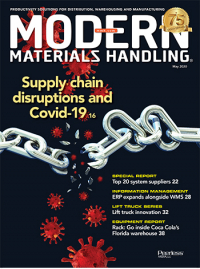60 Seconds with John M. Hill (Updated 2024)
Modern was able to sit down with John M. Hill to discuss the industry and other matters.
Update May 2024: John passed on at age 86 surrounded by family on April 15. Most people consider 40 years to be a career. But John had a much longer run. In 1980, he had already risen to be president of the trade association now known as MHI. At the time of his death, John was still involved with MHI, materials handling and the practice of supply chain. Here is what he had to say about that great run back in 2020 in 60 seconds with...
Title: Director at The St. Onge Company
Location: Watsonville, Calif.
Experience: Nearly 60 years in the materials handling industry
Modern: John, this is a year of milestones. MHI is celebrating its 75th anniversary; we’re in the 75th year of publishing Modern Materials Handling. You’ve worked in AutoID, warehouse management systems (WMS) and materials handling automation over more than 50 years, so let’s get a little perspective on the development of the industry.
Hill: First, I want to tell you how supportive Modern has been throughout my career, and I mean that sincerely. The magazine was very supportive of the bar code and WMS industries when they were first emerging in the 1970s and 80s. I appreciate what it did to support us.
Modern: What brought you into the industry?
Hill: I went to work for 3M in the mid-60s in the field of automatic identification before we called it bar coding. 3M sent me to the Arctic Circle in Northern Sweden where we proved that the precursor to barcoding could work under very severe temperature conditions. From there, I joined Computer Identics, one of the early barcoding companies, not long after it was founded in 1969. I worked in automatic identification for almost 20 years.
Modern: How did the field develop?
Hill: Early on, the technology involved big tags that were put on rail cars, but the founder of Computer Identics had an idea for a miniaturized tag that could be used for traceability in the supply chain. The first customer was General Trading, a retail grocer in Northern New Jersey that used bar codes to support sorting in a warehouse.
Before then, you had individuals at the sort area who typed human readable information into the system to sort the boxes. In December 1970, a group of six suppliers with a combined revenue of maybe $2 million came together to form AIM, which gave us a bigger platform to tell our story. AIM was important because we were able to develop standards for the industry. Those hit the market in the 1980s. Standardization really drove growth and today, AutoID is something like a $30 billion industry.
Modern: What’s changed?
Hill: The concept has stayed the same. What’s changed is that new technologies, like RFID, have come to market, and readability is improved. We used to shoot for 99.9% accuracy, but that only counts if the tag is readable in the first place.
Modern: What about warehouse management systems? You worked for Logisticon, generally credited as the first WMS company.
Hill: Vince Occhipinti, who is now a venture capitalist, is the unsung hero of the WMS industry. I met him in 1974 at the North American Material Handling Show at McCormick Place. He had worked at Raymond with a group that came up with a way to control the movement of wire-guided lift trucks. It included a software system that took inputs from bar code scanners mounted on the lift truck to control the movement of the lift trucks. Sort of like a WMS.
He left Raymond, founded Logisticon and installed the first WMS in 1974 or 1975 in a JCPenney warehouse in Southern California. An industry was born. At that show, he offered me a job that I turned down, but I went to work for him 10 years later. There were just a handful of companies then, but by the late 80s at least 100 companies were espousing expertise in warehouse management.
Modern: I know you continue to watch developing trends. If you were starting your career today, rather than 50 years ago, what would excite you the most?
Hill: I love what’s coming from the robotics community. We’ve been talking about lights out warehouse for at least 20 years, and I think that’s on the horizon. I think the UPC will disappear. Now, it won’t disappear as a concept, but I think new technologies are coming up to replace bar codes. And last, I think push-button inventory taking is within reach. That’s where you’ll be able to sit at a terminal, press a button and get a real-time update of the entire warehouse

Article Topics
MHI News & Resources
Remembering John Hill Consultant and industry leader John M. Hill passes on at age 86 2024 Intralogistics Robotics Survey: Robot demand surges MHI surpasses 1,000 members Modex 2024: Records broken, robots everywhere WERC annual conference program spans education, networking, facility tours Modex 2024 reports record-shattering attendance More MHILatest in Materials Handling
Leaders Q & A with Bryan Ferguson: Resurgence of RFID technology Tom Panzarella appointed Chief Technology Officer at Seegrid Mallard Manufacturing joins the MacLean-Fogg family of companies Boscov’s: Speed regained in retail distribution Women in Manufacturing Association to offer 4th annual Moms in MFG Conference Fox Robotics and KION NA announce strategic partnership Ergonomics update: Hearing protection in the warehouse More Materials HandlingSubscribe to Materials Handling Magazine

Find out what the world's most innovative companies are doing to improve productivity in their plants and distribution centers.
Start your FREE subscription today.
May 2024 Modern Materials Handling

Latest Resources












